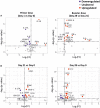Predictive model for BNT162b2 vaccine response in cancer patients based on blood cytokines and growth factors
- PMID: 36618384
- PMCID: PMC9813584
- DOI: 10.3389/fimmu.2022.1062136
Predictive model for BNT162b2 vaccine response in cancer patients based on blood cytokines and growth factors
Abstract
Background: Patients with cancer, especially hematological cancer, are at increased risk for breakthrough COVID-19 infection. So far, a predictive biomarker that can assess compromised vaccine-induced anti-SARS-CoV-2 immunity in cancer patients has not been proposed.
Methods: We employed machine learning approaches to identify a biomarker signature based on blood cytokines, chemokines, and immune- and non-immune-related growth factors linked to vaccine immunogenicity in 199 cancer patients receiving the BNT162b2 vaccine.
Results: C-reactive protein (general marker of inflammation), interleukin (IL)-15 (a pro-inflammatory cytokine), IL-18 (interferon-gamma inducing factor), and placental growth factor (an angiogenic cytokine) correctly classified patients with a diminished vaccine response assessed at day 49 with >80% accuracy. Amongst these, CRP showed the highest predictive value for poor response to vaccine administration. Importantly, this unique signature of vaccine response was present at different studied timepoints both before and after vaccination and was not majorly affected by different anti-cancer treatments.
Conclusion: We propose a blood-based signature of cytokines and growth factors that can be employed in identifying cancer patients at persistent high risk of COVID-19 despite vaccination with BNT162b2. Our data also suggest that such a signature may reflect the inherent immunological constitution of some cancer patients who are refractive to immunotherapy.
Keywords: BNT162b2; COVID-19 vaccine; SARS-CoV-2; chemokines; cytokines; growth factors; haematological malignancies; solid cancers.
Copyright © 2022 Konnova, De Winter, Gupta, Verbruggen, Hotterbeekx, Berkell, Teuwen, Vanhoutte, Peeters, Raats, Massen, De Keersmaecker, Debie, Huizing, Pannus, Neven, Ariën, Martens, Bulcke, Roelant, Desombere, Anguille, Berneman, Goossens, Goossens, Malhotra-Kumar, Tacconelli, Vandamme, Peeters, van Dam and Kumar-Singh.
Conflict of interest statement
The authors declare that the research was conducted in the absence of any commercial or financial relationships that could be construed as a potential conflict of interest.
Figures




Similar articles
-
Reduced Antibodies and Innate Cytokine Changes in SARS-CoV-2 BNT162b2 mRNA Vaccinated Transplant Patients With Hematological Malignancies.Front Immunol. 2022 May 25;13:899972. doi: 10.3389/fimmu.2022.899972. eCollection 2022. Front Immunol. 2022. PMID: 35693807 Free PMC article.
-
Immunogenicity of the BNT162b2 COVID-19 mRNA vaccine and early clinical outcomes in patients with haematological malignancies in Lithuania: a national prospective cohort study.Lancet Haematol. 2021 Aug;8(8):e583-e592. doi: 10.1016/S2352-3026(21)00169-1. Epub 2021 Jul 2. Lancet Haematol. 2021. PMID: 34224668 Free PMC article.
-
Analysis of the humoral and cellular immune response after a full course of BNT162b2 anti-SARS-CoV-2 vaccine in cancer patients treated with PD-1/PD-L1 inhibitors with or without chemotherapy: an update after 6 months of follow-up.ESMO Open. 2022 Feb;7(1):100359. doi: 10.1016/j.esmoop.2021.100359. Epub 2021 Dec 11. ESMO Open. 2022. PMID: 34973510 Free PMC article.
-
Predictors of poor seroconversion and adverse events to SARS-CoV-2 mRNA BNT162b2 vaccine in cancer patients on active treatment.Eur J Cancer. 2021 Dec;159:105-112. doi: 10.1016/j.ejca.2021.09.030. Epub 2021 Oct 11. Eur J Cancer. 2021. PMID: 34742157 Free PMC article.
-
Effect of Different Disease-Modifying Therapies on Humoral Response to BNT162b2 Vaccine in Sardinian Multiple Sclerosis Patients.Front Immunol. 2021 Dec 9;12:781843. doi: 10.3389/fimmu.2021.781843. eCollection 2021. Front Immunol. 2021. PMID: 34956211 Free PMC article.
Cited by
-
TRAIL and IP-10 dynamics in pregnant women post COVID-19 vaccination: associations with neutralizing antibody potency.Front Cell Infect Microbiol. 2024 Mar 20;14:1358967. doi: 10.3389/fcimb.2024.1358967. eCollection 2024. Front Cell Infect Microbiol. 2024. PMID: 38572318 Free PMC article.
-
Machine learning approaches to dissect hybrid and vaccine-induced immunity.Commun Med (Lond). 2025 Jul 8;5(1):282. doi: 10.1038/s43856-025-00987-4. Commun Med (Lond). 2025. PMID: 40629157 Free PMC article.
-
COVID-19 vaccines and neurological disorders: A narrative review of immune responses and adverse reactions.AIMS Neurosci. 2025 Jun 18;12(2):222-249. doi: 10.3934/Neuroscience.2025013. eCollection 2025. AIMS Neurosci. 2025. PMID: 40717731 Free PMC article. Review.
References
-
- Peeters M, Verbruggen L, Teuwen L, Vanhoutte G, Vande Kerckhove S, Peeters B, et al. . Reduced humoral immune response after BNT162b2 coronavirus disease 2019 messenger RNA vaccination in cancer patients under antineoplastic treatment. ESMO Open (2021) 6(5):100274. doi: 10.1016/j.esmoop.2021.100274 - DOI - PMC - PubMed
Publication types
MeSH terms
Substances
Supplementary concepts
LinkOut - more resources
Full Text Sources
Medical
Research Materials
Miscellaneous

